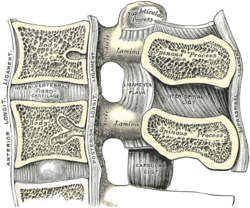| Interspinous ligament | |
|---|---|
 Median sagittal section of two lumbar vertebrae and their ligaments (interspinous ligament visible at center right) | |
| Details | |
| From | Spinous process of vertebra |
| To | Spinous process of vertebra |
| Identifiers | |
| Latin | ligamenta interspinalia |
| TA98 | A03.2.01.002 |
| TA2 | 1674 |
| FMA | 71392 |
| Anatomical terminology | |
The interspinous ligaments (interspinal ligaments) are thin, membranous ligaments that connect adjoining spinous processes of the vertebra in the spine.[1][2] They take the form of relatively weak sheets of fibrous tissue and are well developed only in the lumbar region.[3]
They extend from the root to the apex of each spinous process. They meet the ligamenta flava anteriorly,[4][better source needed] and blend with the supraspinous ligament[3] posteriorly at the apexes of the spinal processes. The function of the interspinous ligaments is to limit ventral flexion of the spine and sliding movement of the vertebrae.[5]
The ligaments are narrow and elongated in the thoracic region. They are broader, thicker, and quadrilateral in form in the lumbar region. They are only slightly developed in the neck;[1] in the neck, they are often considered part of the nuchal ligament.[4][better source needed]
- ^ a b "Gray, Henry. 1918. Anatomy of the Human Body". Bartleby.com. Retrieved 30 March 2013.
- ^ "interspinal ligament". Merriam-Webster. Retrieved 30 March 2013.
- ^ a b Sinnatamby C (2011). Last's Anatomy (12th ed.). Elsevier Australia. p. 424. ISBN 978-0-7295-3752-0.
- ^ a b "Interspinous ligaments". AnatomyExpert. Archived from the original on 22 July 2013. Retrieved 30 March 2013.
- ^ Sobotta Anatomy Textbook. Friedrich Paulsen, Tobias M. Böckers, J. Waschke, Stephan Winkler, Katja Dalkowski, Jörg Mair, Sonja Klebe, Elsevier ClinicalKey. Munich. 2018. p. 120. ISBN 978-0-7020-6760-0. OCLC 1132300315.
{{cite book}}: CS1 maint: location missing publisher (link) CS1 maint: others (link)